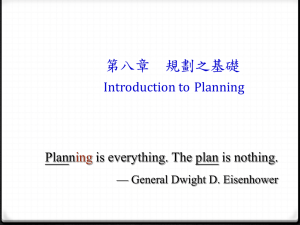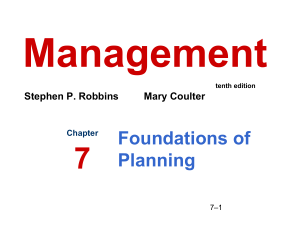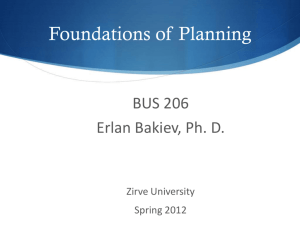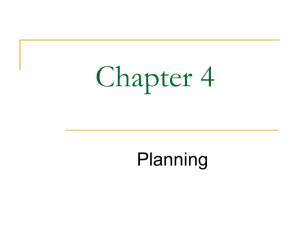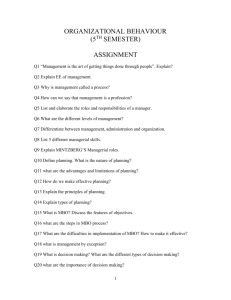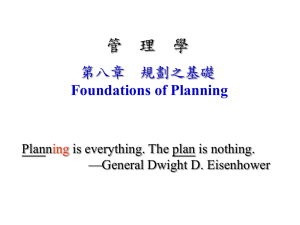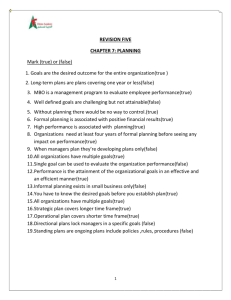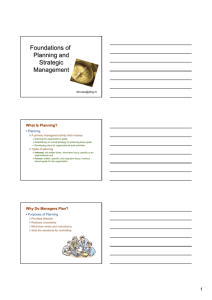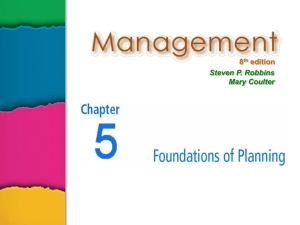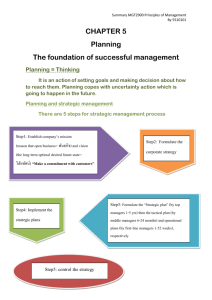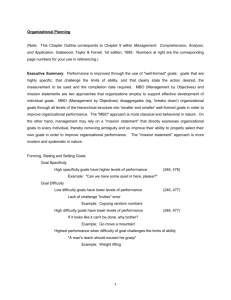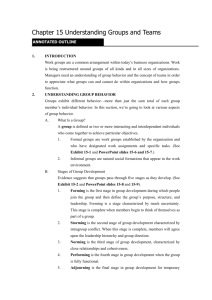Chapter 1 Introduction to Management and Organizations
advertisement
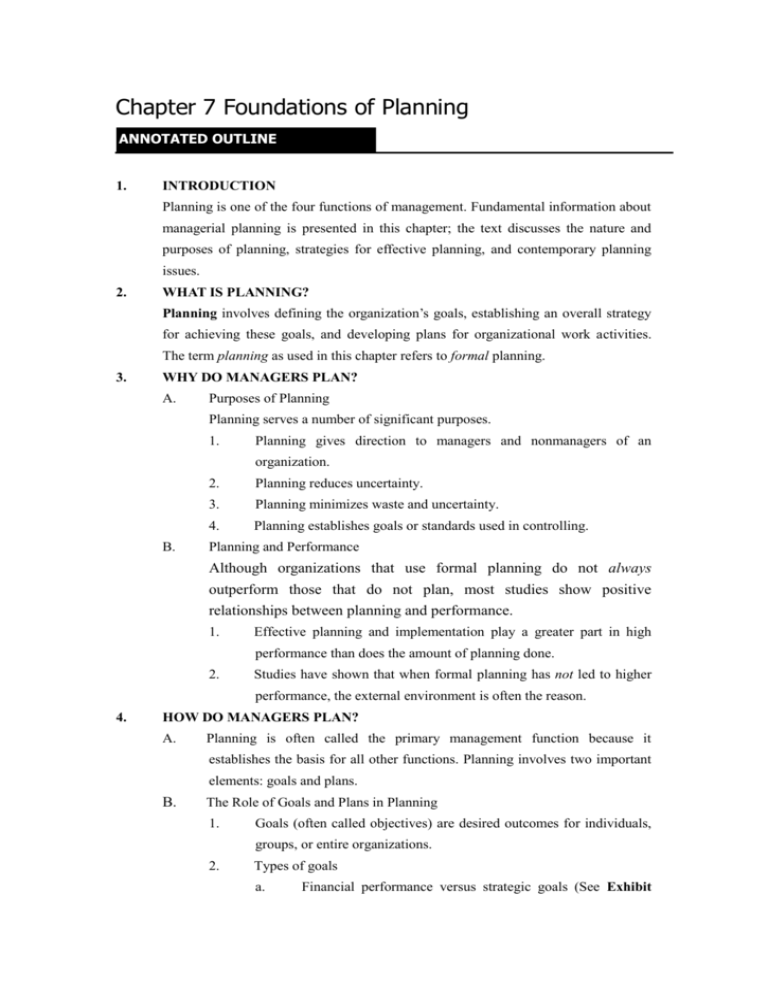
Chapter 7 Foundations of Planning ANNOTATED OUTLINE 1. INTRODUCTION Planning is one of the four functions of management. Fundamental information about managerial planning is presented in this chapter; the text discusses the nature and purposes of planning, strategies for effective planning, and contemporary planning issues. 2. WHAT IS PLANNING? Planning involves defining the organization’s goals, establishing an overall strategy for achieving these goals, and developing plans for organizational work activities. The term planning as used in this chapter refers to formal planning. 3. WHY DO MANAGERS PLAN? A. Purposes of Planning Planning serves a number of significant purposes. 1. Planning gives direction to managers and nonmanagers of an organization. B. 2. Planning reduces uncertainty. 3. Planning minimizes waste and uncertainty. 4. Planning establishes goals or standards used in controlling. Planning and Performance Although organizations that use formal planning do not always outperform those that do not plan, most studies show positive relationships between planning and performance. 1. Effective planning and implementation play a greater part in high performance than does the amount of planning done. 2. Studies have shown that when formal planning has not led to higher performance, the external environment is often the reason. 4. HOW DO MANAGERS PLAN? A. Planning is often called the primary management function because it establishes the basis for all other functions. Planning involves two important elements: goals and plans. B. The Role of Goals and Plans in Planning 1. Goals (often called objectives) are desired outcomes for individuals, groups, or entire organizations. 2. Types of goals a. Financial performance versus strategic goals (See Exhibit 7-1 and PowerPoint slide 7-10). b. Stated goals versus real goals 1) Stated goals are official statements of what an organization says and what it wants its various stakeholders to believe its goals are. 2) Real goals are those that an organization actually pursues, as defined by the actions of its members. 3. Types of Plans Plans can be described by their breadth, time frame, specificity, and frequency of use (see Exhibit 7-2 and PowerPoint slide 7-11). a. Breadth: Strategic versus operational plans. Strategic plans (long-term plans) are plans that apply to the entire organization, establish the organization’s overall goals, and seek to position the organization in terms of its environment. Operational plans (short-term plans) are plans that specify the details of how the overall goals are to be achieved. b. Time frame: Short-term versus long-term plans. Short-term plans are plans that cover one year or less. Long-term plans are plans with a time frame beyond three years. c. Specificity: Specific versus directional plans. Specific plans are plans that are clearly defined and leave no room for interpretation. Directional plans are flexible plans that set out general guidelines. (See Exhibit 7-3 and PowerPoint slide 7-14 for illustrations on how specific planning and directional planning differ.) d. Frequency of use: Single-use versus standing plans. A single-use plan is a one-time plan specifically designed to meet the needs of a unique situation. Standing plans are ongoing plans that provide guidance for activities performed repeatedly. 5. ESTABLISHING GOALS AND DEVELOPING PLANS A. Approaches to Establishing Goals Goals can be established through the process of traditional goal setting or through MBO (management by objectives). 1. Traditional goal setting is an approach to setting goals in which goals are set at the top level of the organization and then broken into subgoals for each level of the organization. a. Traditional goal setting assumes that top managers know what is best because of their ability to see the “big picture.” Employees are to work to meet the goals for their particular area of responsibility. b. This traditional approach requires that goals must be made more specific as they flow down to lower levels in the organization. In striving to achieve specificity, however, objectives sometimes lose clarity and unity with goals set at a higher level in the organization (see Exhibit 7-4 and PowerPoint slide 7-17). c. When the hierarchy of organizational goals is clearly defined, it forms an integrated means-end chain—an integrated network of goals in which the accomplishment of goals at one level serves as the means for achieving the goals, or ends, at the next level. 2. Management by objectives (MBO) is a process of setting mutually agreed-upon goals and using those goals to evaluate employee performance. a. Exhibit 7-5 and PowerPoint slide 7-20 list the steps in a typical MBO program. b. Studies of actual MBO programs confirm that MBO can increase employee performance and organizational productivity. However, top management commitment and involvement are important contributions to the success of an MBO program. 3. Whether an organization uses a more traditional approach to establishing objectives, uses some form of MBO, or has its own approach, managers must define objectives before they can effectively and efficiently complete other planning activities. B. C. Characteristics of Well-Designed Goals (See Exhibit 7-6): 1 Written in terms of outcomes 2. Measurable and quantifiable 3. Clear as to a time frame 4. Challenging, but attainable 5. Written down 6. Communicated to all organizational members Five Steps in Goals Setting 1. Review the organization’s mission (the purpose of the organization). 2. Evaluate available resources. 3. Determine the goals individually or with input from others 4. Write down the goals and communicate them to all who need to know. 5. Review results and whether goals are being met. Make changes as needed. D. Developing Plans The process of developing plans is influenced by three contingency factors and by the particular planning approach used by the organization. 1. Three Contingency Factors in Planning: a. Manager’s level in the organization (see Exhibit 7-7 and PowerPoint slide 7-25). Operational planning usually dominates the planning activities of lower-level managers. As managers move up through the levels of the organization, their planning becomes more strategy oriented. b. Degree of environmental uncertainty. 1) When uncertainty is high, plans should be specific, but flexible. 2) Managers must be prepared to rework and amend plans, or even to abandon their plans if necessary. c. Length of future commitments 1) According to the commitment concept, plans should extend far enough to meet those commitments made today. 2) Planning for too long or for too short a time period is inefficient and ineffective. 2. Approaches to Planning a. In the traditional approach, planning was done entirely by top-level managers who were often assisted by a formal planning department. b. Another approach to planning is to involve more members of the organization in the planning process. In this approach, plans are not handed down from one level to the next, but are developed by organizational members at various levels to meet their specific needs. 6. CONTEMPORARY ISSUES IN PLANNING The concluding section of Chapter Seven examines criticisms of planning and addresses how managers can plan effectively in dynamic environments. A. Criticisms of Planning Although planning is an important managerial function with widespread use, five major arguments have been directed against planning: 1. Planning may create rigidity. Formal planning may “lock” an organization into specific goals and specific timetables that were established under certain environmental conditions. If the environment changes, managers may believe they are locked into the current plans. 2. Plans can’t be developed for a dynamic environment. Managing under chaotic environmental conditions requires flexibility, and this may mean not being tied to formal plans. 3. Formal plans can’t replace intuition and creativity. The formal planning process may emphasize the mechanics and routines of planning, sometimes inhibiting creativity and innovation. 4. Planning focuses managers’ attention on today’s competition, not on tomorrow’s survival. An organization that uses formal planning has a tendency to focus on existing opportunities rather than on creating or reinventing an industry, and competitors may take the lead. 5. Formal planning reinforces success, which may lead to failure. Because the existing plans have led to success, managers may be reluctant to change or discard previously successful plans. The mentality may be, “If it’s not broken, why fix it?” B. Effective Planning in Dynamic Environments. The external environment is constantly changing. 1. Managers should develop plans that are specific, but flexible. 2. Managers must recognize that planning is an ongoing process, and they should be willing to change directions if environmental conditions warrant. 3. Flexibility is particularly important. 4. Managers must remain alert to environmental changes that could impact the effective implementation of plans, and they must be prepared to make changes as needed.
